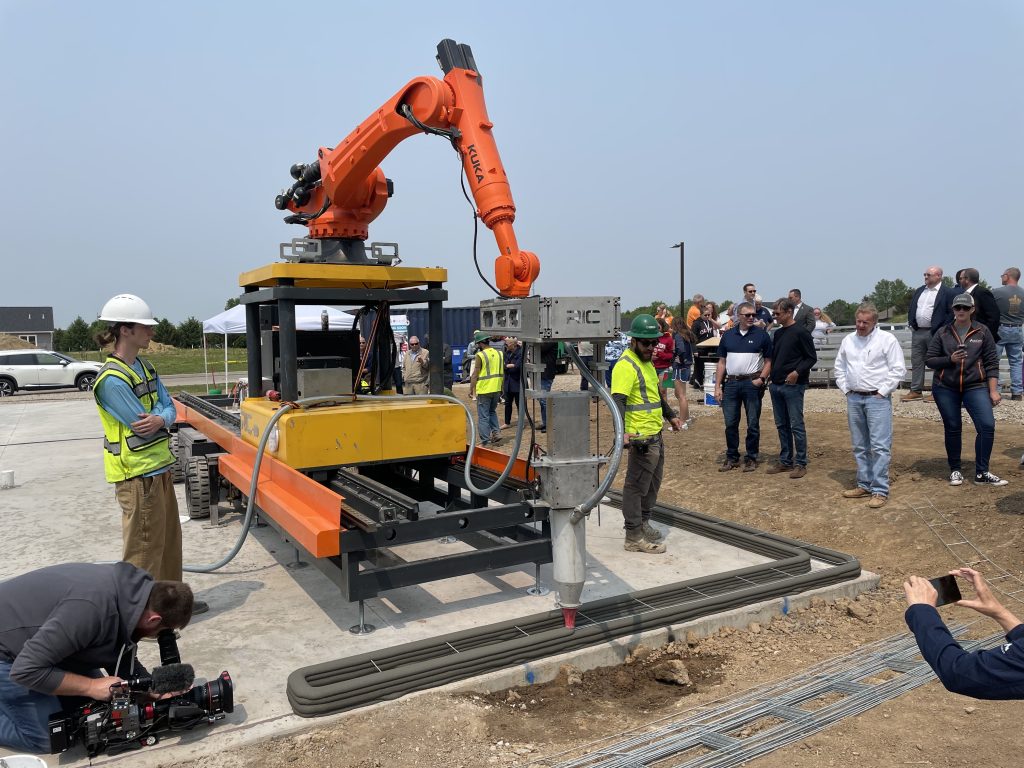Build Construction Group has partnered with the City of Walnut and the Los Angeles County Fire Department to construct the U.S.’s first fire-resistant, onsite-built concrete accessory dwelling unit (ADU) in Walnut.
Led by Builtech Construction Group, the project is progressing smoothly, with the installation of plumbing and sewage systems currently underway. Following this phase, RIC Technology‘s robotic arm will undertake the on-site 3D printing of the ADU’s concrete walls, with K4K Construction Design subcontracted for the printing process. The printing process is expected to take around 20 days according to the company.
Ziyou Xu, Founder and CEO of RIC Technology, explained why this project is a breakthrough in concrete 3D printing’s application to ADU and other affordable housing projects, “Our compact modular robotic 3D printer overcomes conventional gantry systems’ limitations, enabling 3D construction on site, in confined space such as people’s backyards.”

Fireproof construction on the rise
Walnut residents Philips and Constance are taking proactive steps to mitigate wildfire risks by teaming up with Builtech Construction Group to build a fire-resistant ADU in their backyard. Boasting 2 bedrooms and 2.5 bathrooms, this 1200 sqft unit stands out for its non-combustible features. “This project can be the beginning of something meaningful – a wider application of 3D printed homes that are less susceptible to fires,” added Xu.
Aaron Liu, CEO of Builtech Construction Group and an NFPA-certified wildfire mitigation specialist (CWMS), said, “During wildfires, ‘heat’ and ‘oxygen’, two of the three components of the fire triangle, are beyond control. Therefore, our focus is on eliminating ‘fuel,’ the unique architectural design and building materials in this case.”
The ADU project will employ construction methods, including 3D printing with concrete for its exterior walls, a non-combustible material. Unlike many other 3D printed homes, the ADU’s roof will be composed of light steel and sure-boards instead of wood.
Builtech’s strategy also entails reinforcing traditionally vulnerable areas such as eave vents and windows to bolster the structure’s fire resistance. According to Aaron, the project will completely forgo wood and nails in the main structure, minimizing the risk of fire penetration and significantly reducing the home’s susceptibility to fire.
Walnut ADU sets new standard for wildfire defense
According to findings from the USDA Forest Service‘s Wildfire Risk to Communities initiative, embers and minor flames frequently ignite the initial stages of home destruction during wildfires. By mitigating a home’s susceptibility to fire, its chances of enduring a wildfire increase significantly.
Xu explained that such structures not only enhance resilience during a fire but also expedite post-wildfire recovery efforts. Surviving a wildfire significantly reduces both the time and financial costs associated with recovery for homeowners. Despite California’s stringent building codes, the project was able to receive construction permits in February.
The Walnut project is expected to catalyze further collaborations with local governments and fire departments, aiming to expand these fire-resistant constructions to more communities in California affected by wildfires, says the company. In the future, RIC Technology plans to continue its partnership with Builtech Construction Group, focusing on the development of non-combustible, fire-resistant homes in wildfire-prone areas.

Globally stretching construction 3D printing landscape
Construction 3D printing offers numerous benefits such as increased speed of construction, reduced material waste, lower labor costs, and the ability to create complex designs that may be otherwise challenging with traditional construction methods.
One notable example includes, Rotterdam-based Studio RAP completed a unique project in Amsterdam’s shopping district. The project leveraged 3D printing to renovate a three-story townhouse with a distinct rippled facade. This design was achieved through a combination of computational design, robotics, and ceramic craftsmanship, resulting in custom ceramic tiles.
These tiles are algorithmically designed and 3D printed to create intricate patterns inspired by textiles. The project showcases Studio RAP’s interest in exploring 3D printed architecture to potentially reduce construction time and costs. Before this, the company gained recognition for its work on two vaulted gates in Delft, where it applied a distinctive blue ceramic treatment to the interiors.
Elsewhere, real estate development company Emaar Properties unveiled Dubai’s first 3D printed villa, which features three bedrooms, four bathrooms, and Smart Home integration. This initiative aligns with Dubai’s ‘Smart City’ vision, aiming to have 25% of constructions 3D printed by 2030.
Collaborating with COBOD and Xiaomi, the villa showcased advanced additive manufacturing technology. Constructed using COBOD’s BOD2 3D printer, the project highlighted Emaar’s first step into construction 3D printing, promising faster, cost-effective builds with reduced waste and noise pollution, all while achieving distinctive designs.
What 3D printing trends do the industry leaders anticipate this year?
What does the Future of 3D printing hold for the next 10 years?
To stay up to date with the latest 3D printing news, don’t forget to subscribe to the 3D Printing Industry newsletter or follow us on Twitter, or like our page on Facebook.
While you’re here, why not subscribe to our Youtube channel? Featuring discussion, debriefs, video shorts, and webinar replays.
Are you looking for a job in the additive manufacturing industry? Visit 3D Printing Jobs for a selection of roles in the industry.
Featured image shows Walnut ADU breaking ground. Photo via RIC Technology.



